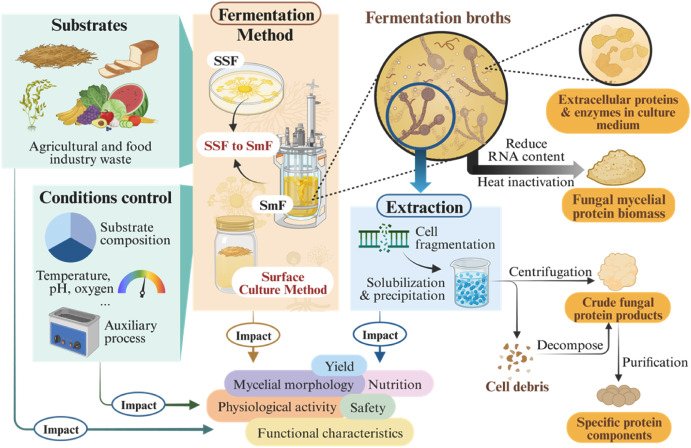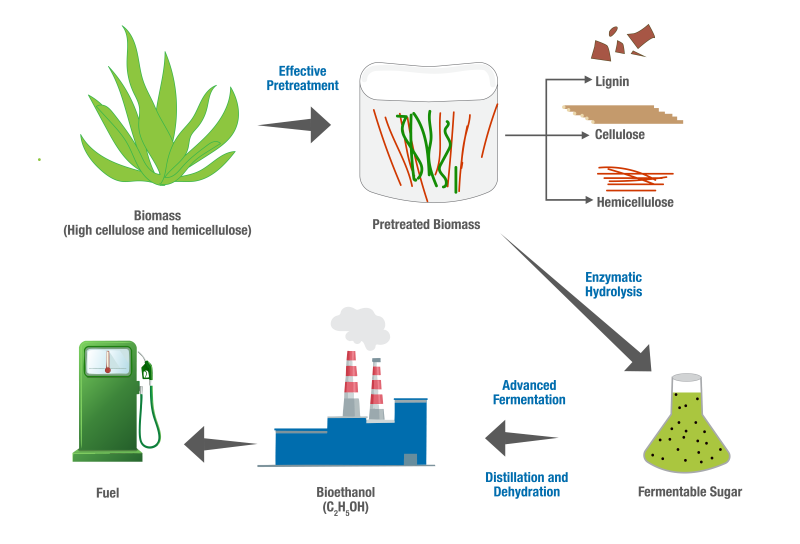
Summaries:
- Biomass fermentation involves microorganisms, such as bacteria and fungi, decomposing organic materials (biomass) to create valuable outputs, including biofuels, chemicals, and alternative proteins.
- Materials with sugar need the least expensive pretreatment, while starchy, lignocellulosic materials and urban wastes require more expensive pretreatment to transform into fermentable substrates.
- Acidogenic bacteria subsequently transform sugars and amino acids into carbon dioxide, hydrogen, ammonia, and organic acids.
The properties of the final product will be affected by the biomass fermentation process. Three primary methods consist of solid-state fermentation (SSF), submerged fermentation (SmF), and liquid-air interface fermentation (LAIF). Each of the three presents both pros and cons, impacting elements like the types of microbes applied, energy expenses, output, and scalability.
In SSF, microbes develop on a solid substrate within a fermentation space regulated for temperature and air. SmF entails the proliferation of microbes in a liquid culture medium, necessitating the utilization of large fermentation tanks.
Cultivating Microbes in Liquid Culture Necessitates the Utilization of Fermentation Vessels
Biomass fermentation involves microorganisms, such as bacteria and fungi, decomposing organic materials (biomass) to create valuable outputs, including biofuels, chemicals, and alternative proteins. It utilizes the rapid development and elevated protein levels of microorganisms to effectively produce these items.
The type of microorganism determines whether aerobic or anaerobic fermentation of biomass is utilized. Once more, there are advantages and disadvantages to each production method. For instance, anaerobic fermentation may be more cost-effective as it doesn’t need an oxygen source; however, it can generate more harmful byproducts compared to aerobic fermentation, which typically offers greater yields.
Read More:
- How Mineralization Can Help Reducing Carbon Emission
- China Plans to Cut Out Carbon Dioxide (CO2) on 2035
Fermenting Forest and Industrial Waste Materials
Materials that contain sugars or can be converted into sugars may serve as substrates for fermentation. The fermentable feedstocks can be categorized into directly fermentable sugary substances, starchy materials, lignocellulosic resources, and industrial byproducts.
Materials with sugar need the least expensive pretreatment, while starchy, lignocellulosic materials and urban wastes require more expensive pretreatment to transform into fermentable substrates.
Fermenting Agricultural Byproducts

Traditional crops like corn and sugarcane can not satisfy the worldwide need for bioethanol production because their main purpose is for food and feed. Consequently, lignocellulosic materials like agricultural waste make appealing raw materials for bioethanol production.
Agricultural byproducts are affordable, renewable, and plentiful. Bioethanol produced from agricultural waste presents a promising technology, yet the process encounters various challenges and limitations, including biomass transportation and management, along with effective pretreatment methods for complete delignification of lignocellulosic materials.
Appropriate pretreatment techniques can enhance the levels of fermentable sugars following enzymatic saccharification, thus boosting the overall process efficiency. Transforming glucose and xylose into ethanol requires innovative fermentation technologies to render the entire process economical.
Anaerobic Digestion (AD)

Anaerobic digestion (AD) is a process that involves the breakdown of plant or animal materials through microbial activity without the presence of air, resulting in the production of a gas rich in methane. This methane can be collected and ignited to generate heat, electricity, or both together.
It is extensively utilized in agriculture through small on-farm digesters that generate biogas for heating farmhouses and various agricultural structures. The primary forms of organic material feedstock utilized in AD are sewage sludge, agricultural slurry, and municipal solid waste (MSW).
The process of digestion starts with the hydrolysis of the input materials by bacteria. Insoluble organic polymers, like carbohydrates, are decomposed into soluble derivatives that become accessible for other bacteria. Acidogenic bacteria subsequently transform sugars and amino acids into carbon dioxide, hydrogen, ammonia, and organic acids.
During acetogenesis, bacteria transform these generated organic acids into acetic acid, as well as producing extra ammonia, hydrogen, carbon dioxide, and various other compounds. Ultimately, methanogens transform these byproducts into methane and carbon dioxide. The populations of methanogenic archaea are crucial in anaerobic wastewater treatment processes.
Anaerobic digestion is utilized as a component of the procedure to manage biodegradable waste and sewage sludge. When incorporated into a comprehensive waste management system, it lowers the release of landfill gas into the air. Additionally, it can utilize energy crops cultivated specifically for this purpose, such as maize.
Anaerobic digestion is commonly employed as a source of sustainable energy. The procedure generates biogas, composed of methane, carbon dioxide, and small amounts of other ‘impurity’ gases. This biogas can be utilized directly as fuel, in combined heat and power gas engines, or processed to achieve natural gas-quality biomethane. The nutrient-dense digestate generated can serve as fertilizer.
Numerous microorganisms influence anaerobic digestion, such as acetic acid-producing bacteria (acetogens) and methane-producing archaea (methanogens). These organisms facilitate several chemical processes in transforming biomass into biogas.
Read More:
- Biomass Carbon Removal & Storage (BiCRS) for Remove Carbon Pollution
- Indonesian Carbon Capture & Sequestration Regulation Overview
Populations of anaerobic microorganisms generally require a considerable amount of time to fully establish themselves to be effective. Consequently, standard protocol involves introducing anaerobic microorganisms from materials that already contain populations, a method referred to as “seeding” the digesters, which is usually done by adding sewage sludge or cattle slurry.
#ZonaEBT #Sebarterbarukan #EBTHeroes
Editor: Tri Indah Lestari
References:
[1] Biomass Fermentation: The Most Flexible Alt Protein Technology?
[2] Anaerobic digestion


